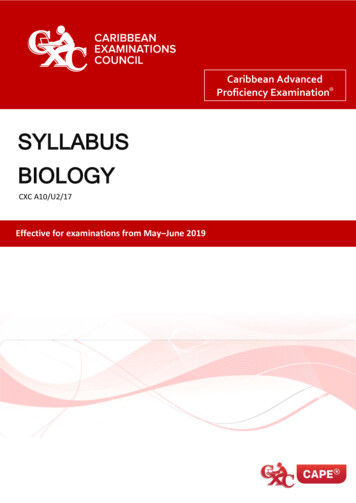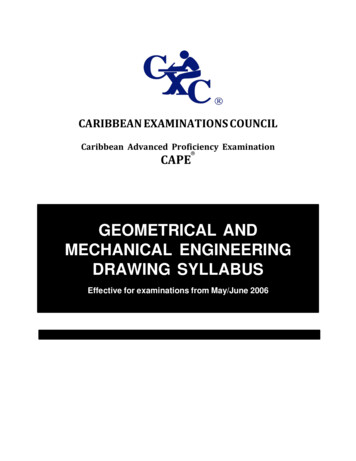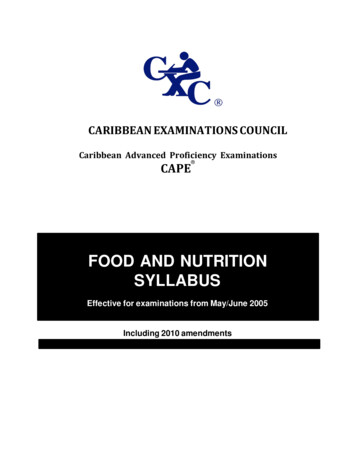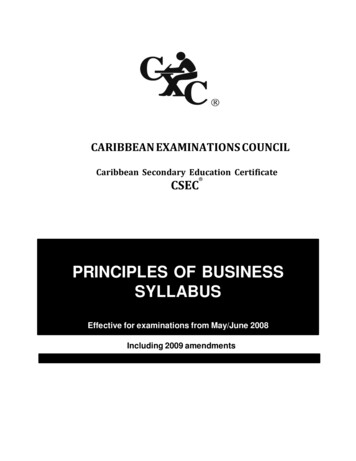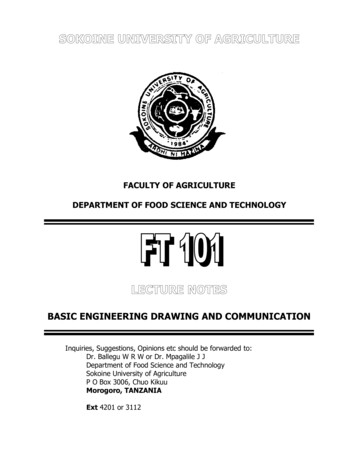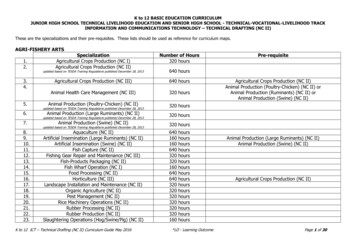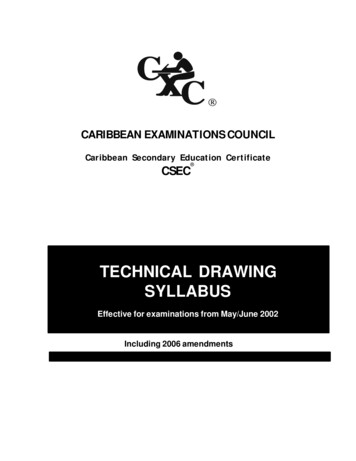
Transcription
CARIBBEAN EXAMINATIONS COUNCILCaribbean Secondary Education CertificateCSEC TECHNICAL DRAWINGSYLLABUSEffective for examinations from May/June 2002Including 2006 amendmentsCXC 13/O /SYLL 00A1
Published by the Caribbean Examinations CouncilAll rights reserved. No part of this publication may be reproduced, stored in a retrieval system, ortransmitted in any form, or by any means electronic, photocopying, recording or otherwise withoutprior permission of the author or publisher.Correspondence related to the syllabus should be addressed to:The Pro-RegistrarCaribbean Examinations CouncilCaenwood Centre37 Arnold Road, Kingston 5, Jamaica, W.I.Telephone: (876) 630-5200Facsimile Number: (876) 967-4972E-mail address: cxcwzo@cxc.orgWebsite: www.cxc.orgCopyright 2000, by Caribbean Examinations CouncilThe Garrison, St Michael BB14038, BarbadosCXC 13/O /SYLL 00/A1ii
ContentRationale for Teaching Technical Drawing . 1General Objectives .1Organization of the Syllabus .3-5Format of the Examination.5-8Unit 1 – Plane and Solid Geometry.9-16Unit 2 – Building Drawing .17-20Unit 3 – Mechanical Engineering Drawing .21-24Recommended Minimum Equipment /Material for Technical Drawing Syllabus . 25-27Recommended Texts .28CXC 13/O /SYLL 00/A1iii
AMENDMENTSThe Technical Drawing Syllabus, previously included in the Industrial Arts Syllabus, is nowpublished under its own cover. The syllabus was revised in 2000 for first examination in 2002.The major amendments are indicated by vertical lines.Attention is drawn to the following:i)the organisation of the syllabus into Units and Modules;ii)the merging of the Plane and the Solid Geometry sections into Unit1:Plane and Solid Geometry;iii)the revision of the percentage weighting of papers and profile dimensions;iv)the rewriting of Unit 3: Mechanical Engineering Drawing;v)the restructuring of the School-Based Assessment component;vi)the addition of Computer Aided Drafting as an option.CXC 13/O /SYLL 00/A1iv
Technical Drawing Syllabus RATIONALE FOR TEACHING TECHNICAL DRAWINGIt is generally recognised that Technical Drawing is the language of communication oftechnical/vocational occupations and as such, has widespread applications in the life of consumers. Itis, therefore, being recommended that every secondary school student should have, at theminimum, a basic knowledge of Technical Drawing.To this end, the Caribbean Examinations Council recognises the need to provide a programme ofstudies in Technical Drawing which will cater not only to the above stated interest, but also tothose students who will proceed to studies at tertiary levels and/or seek entry level employment inrelated fields.The Technical Drawing course as conceived, therefore, will be an essential companion to the cognateCSEC Industrial Technology programme as well as an integral component of the GeneralEducation curriculum.The syllabus also contributes to the development of selected attributes from the CARICOM Ideal Person document asarticulated by the CARICOM Heads of Government. This person is one who demonstrates emotional security with ahigh level of self-confidence and self-esteem, is aware of the importance of living in harmony with the environment andnurtures its development in the economic and entrepreneurial spheres in all other areas of life (CARICOM EducationStrategy, 2000).This holistic development of students aligns with selected competencies advocated in the UNESCO Pillars of learning.These are learning to be, learning to do, and learning to transform one’s self and society. GENERALOBJECTIVESThis syllabus is designed for candidates to:(i)develop an understanding of and appreciation of Technical Drawing in the CaribbeanIndustrial Society;(ii)discover and develop their talents in the fields of Technical Drawing and relatedtechnologies;(iii)develop technical problem-solving skills in Technical Drawing as related to materials andCXC 13/O /SYLL 00/A11
processes;(iv)develop the correct and accepted Technical Drawing skills as demanded by Industry;(v)be aware of the career opportunities available in Technical Drawing and its related fields;(vi)have a working knowledge and understanding of Computer Aided Drafting applications;(vii)develop skills to use drawing in the process of design. CERTIFICATION AND DEFINITION OF PROFILESThe Technical Drawing course is an integral component of the Technical/Vocational Educationprogramme offered by the Council. Commencing May/June 2005, Technical Drawing will beexamined for certification at the General Proficiency only1. Ca n d i d a t e s h a v e t h e o p t i o n o fus i n g t he C o m put e r - Ai d e d D r a f t i n g ( CAD ) m e t h o d / a p p l i c a t i o n t o c o m p l e t e P a p e r 0 2 ,Pa p e r 0 3 a n d t h e S B A c o m p o n e n t o f t h e s y l l a b u s .Candidates will be awarded an overall grade reported on a 6-point scale, that is, Grades 1-6. Inaddition to the overall grade, candidate’s performance will also be reported under the profiledimensions, Knowledge, Application and Practical Ability.DefinitionsKnowledgeRecall and comprehension of terms, principles, methods, theoriesand structures; interpretation and extrapolation;ApplicationUse of concepts, principles, methods and theories to solveproblems in a given situation; analysis, synthesis and evaluation;Practical AbilityDemonstration of manipulative skills involving the use of drawinginstruments, equipment and materials in problem solvingsituations.CANDIDATE POPULATIONThe syllabus is designed to be covered in the final two years of the five-year secondary schoolprogramme and is intended for students enrolled in a full-time programme. However, candidateswho do not attend school full-time may undertake the course by observing the following guidelines:A.Regulations for Private Institutions(i)1Candidates entering for the examination through private institutions recognizedPlease refer to letter dated November 4, 2002 to Ministries of Education, Schools and Local Registrars.CXC 13/O /SYLL 00/A12
by the Council will be required to complete all the components of the respectiveproficiencies.(i)B.The School-Based Assessment of such candidates must be monitored by the tutorsin the institution through which they register.Regulations for Private Candidates(i)“A private candidate is one not entered through a school or other approvededucational institution”.(ii)A private candidate will be required to complete all the components of therespective proficiencies.(iii)A private candidate must identify a teacher/tutor from a registered institution(school/technical institute/community college) who will assess and approve thecandidate’s submission for the School-Based Assessment component of the syllabus.The name, school, and territory of the identified teacher/tutor should be submittedto the Council on registration for the subject.ALLIED SUBJECTSSchool candidates should be encouraged to include the following subjects in their programme ofstudy: one of the Industrial Technology subjects (Building Technology; Mechanical EngineeringTechnology; Electrical and Electronic Technology), English A, Mathematics, Physics.SUGGESTED TIME ALLOCATIONIt is recommended that a minimum of five 40-minute periods per week with no single period beallocated to the subject over a two-year period. ORGANIZATION OF THE SYLLABUSThe syllabus is divided into three Units:UNIT 1UNIT 2UNIT 3-Plane and Solid GeometryBuilding DrawingMechanical Engineering DrawingCandidates are expected to undertake UNIT 1: Plane and Solid Geometry and EITHER UNIT 2:Building Drawing OR UNIT 3: Mechanical Engineering Drawing.CERTIFICATION AND DEFINITION OF PROFILESThe Technical Drawing course is an integral component of the Technical/Vocational Educationprogramme offered by the Council. It will, therefore, be examined for certification at both Basicand General Proficiencies. Candidates have the option of using either the Traditional DrawingMethod (drawing board and tee square) or Computer Aided Drafting method/applications toCXC 13/O /SYLL 00/A13
complete the objectives of the syllabus.Candidates will be awarded an overall grade reported on a 6-point scale, that is, Grades 1-6. Inaddition to the overall grade, candidate’s performance will also be reported under the profiledimensions, Knowledge, Application and Practical Ability.DEFINITIONSKnowledgeRecall and comprehension of terms, principles, methods, theories andstructures; interpretation and extrapolation;ApplicationUse of concepts, principles, methods and theories to solveproblems in a given situation; analysis, synthesis and evaluation;Practical AbilityDemonstration of manipulative skills involving the use of drawinginstruments, equipment and materials in problem solvingsituations.(Distinction between Basic and General Proficiency)The Basic Proficiency or “Core” syllabus provides the minimum Technical Drawing skills andcompetencies.For the General Proficiency, the syllabus is augmented by additional modules to ensure a moreextensive knowledge and understanding of the subject. General Proficiency candidates willnormally be expected to proceed to further studies in their chosen subject areas and should be ableto respond at a higher level to any of the modules listed in the syllabus, so as to demonstrate theirability to recall and apply the knowledge gained in the solution of problems of a practical nature.Accordingly, the examinations for Basic Proficiency and General Proficiency differ in:(i)the extent of the syllabus content to be covered;(ii)the degree of difficulty of questions in papers other than Paper 1;(iii)the relative importance of the three profile dimensions - Knowledge, Application,Practical Ability;The syllabus coverage required is as follows:BASIC PROFICIENCYUNIT 1:Solid Geometry)All areas except Module IX, Auxiliary Projections and Module (Plane andXI, Helical Curves.CXC 13/O /SYLL 00/A14
EITHERUNIT 2: (Building Drawing)All areas except detailed section of staircases, walls and floors.UNIT 3: (Mechanical Engineering Drawing) All areas except SectionalAssembly Drawings.GENERAL PROFICIENCYUNIT 1: (Plane and Solid Geometry)All areasEITHERUNIT 2: (BuildingDrawing) All areasORUNIT 3: (Mechanical EngineeringDrawing) All areas FORMAT OF THE EXAMINATIONBASIC PROFICIENCYPaper 01multiple (¼ hours)A paper common to Basic and General Proficiencies. Sixty (60)choice items on Unit 1 (except Auxiliary Projection, Module IXand Helical Curves, Module XI) - Knowledge, Application andPractical Ability will be tested in the approximate ratio 5:4:1. Each itemwill be worth one mark.Paper 02(1½ hours)Plane and Solid GeometrySix structured questions on the same Unit as Paper 1 – threequestions will be set on Modules I-VI and three on Modules VII, VIIIand X. Candidates must attempt three questions but not more thantwo from any part. Each question will be worth 20 marks distributed inthe approximate ratio: Knowledge 3: Application 7: Practical Ability10.Paper 03(2½ hours)Building or Mechanical Engineering Drawing (Traditional)Six structured questions testing the objectives of Modules in Unit2: Building Drawing and Unit 3: Mechanical Engineering Drawing.Three questions will be set on Building Drawing and three onMechanical Engineering Drawing. Candidates must attempt twoquestions: one working/assembly drawing and one sketch and design(from area of choice). The working/assembly drawing will be worth60 marks of which10 marks will be for (Knowledge), 20 for (Application) and 30 for(Practical Ability). The sketch and design question will be worth 20marks of which 5 will be for (Knowledge), 7 for (Application) and 8 for(Practical Ability).CXC 13/O /SYLL 00/A15
ORPaper 03(2½ hours)Building or Mechanical Engineering Drawing (Computer)Six structured questions testing the objectives of Modules in Unit2: Building Drawing and Unit 3: Mechanical Engineering Drawing.Three questions will be set on Building Drawing and three onMechanical Engineering Drawing. Candidates must attempt twoquestions: one 2D working/assembly drawing and one 3D solid modeldesign drawing (from area of choice). The working/assembly drawingwill be worth 60 marks of which 10 marks will be for (Knowledge), 20for (Application) and 30 for (Practical Ability). The solid model designdrawing question will be worth 20 marks of which 5 will be for(Knowledge), 7 for (Application) and 8 for (Practical Ability).BASIC PROFICIENCYSchool-Based AssessmentDuring the fourth and fifth terms of the course, candidates will be required to complete a projecttesting the candidates’ ability to design/redesign a Building component or Mechanical Engineeringdevice/gadget to solve a simple functional problem in one of the ten categories, viz:CategoriesI)ii)iii)iv)v)HouseholdEducation facilitiesAgriculture/FishingHealth OfficePowerRecreationConstructionManufacturingThe drawing project will carry 50 marks – 5 for Knowledge, 20 for Application and 25 for PracticalAbility and will account for 20% of the composite score.Candidates will be required to prepare a complete set of working drawings of the Building componentor Mechanical Engineering device/gadget. Sketches, working/assembly drawings should be kept in aportfolio (laboratory book) which will be assessed by the teacher.NB:The drawing project must be done in its entirety in the classroom/laboratory under thesupervision of a teacher. It is anticipated that the project will not be done under examinationconditions. However, the teacher is expected to ensure that the project is developed underhis/her supervision and reflects solely the candidate’s efforts. Candidates selecting theTraditional Drawing Method may complete the SBA drawing project using the ComputerAided Drafting Method/applications.CXC 13/O /SYLL 00/A16
GENERAL PROFICIENCYPaper 01hours)A paper common to Basic and General Proficiencies. Sixty (60) multiple (1¼choice items on Unit 1 (except Auxiliary Projection Module IX andHelical Curves Module XI) – Knowledge, Application and Practical Abilitywill be tested in the approximate ratio 5:4:1. Each item will be worthone mark.Paper 02(1½ hours)Plane and Solid GeometryEight questions on Modules of Unit 1– four questions will be set onModules I – VI and four on Modules VII - XI. Candidates must attempt fourquestions, two from each part.Each question will be worth 20 marksdistributed in the ratio 4:7:9 for (Knowledge), (Application), and (PracticalAbility).Paper 03(3 hours)Building and Mechanical Engineering Drawing (By Traditional Method)Eight questions testing the objectives of Modules in Unit 2:BuildingDrawing and Unit 3: Mechanical Engineering Drawing of the syllabus. Fourquestions on Building Drawing and four questions on Mechanical EngineeringDrawing. Candidates must attempt two questions: one sectionalworking/assembly drawing and one sketch and design from area of choice. Thesectional working/assembly drawing question will be worth 80 marks ofwhich 16 will be for (Knowledge), 32 for (Application) and 32 for (PracticalAbility). The sketch and design question will be worth 20 marks of which 3will be for (Knowledge), 7 for (Application) and 10 for (Practical Ability).ORPaper 03(3 hours)Building and Mechanical Engineering Drawing (By Computer)Eight questions testing the objectives of Modules in Unit 2: BuildingDrawing and Unit 3: Mechanical Engineering Drawing of the syllabus.Four questions on Building Drawing and four questions on MechanicalEngineering Drawing. Candidates must attempt two questions: onesectional 2D working/assembly drawing and one 3D solid model designdrawing from area of choice. The sectional working/assembly drawingquestion will be worth 80 marks of which 16 will be for (Knowledge), 32for (Application) and 32 for (Practical Ability). The 3D solid model anddesign drawing question will be worth 20 marks of which 3 will be for(Knowledge), 7 for (Application) and 10 for (Practical Ability).SCHOOL-BASED ASSESSMENTApart from the allocation of marks, the project is the same as for the Basic Proficiency. However,candidates must include a full or part sectional view of the fully assembled component ordevice/gadget for the Building or Mechanical Engineering Unit. The project will carry 60 marks –6 for Knowledge, 24 for Application and 30 for Practical Ability and will account for 20% of thecomposite score.CXC 13/O /SYLL 00/A17
REGULATIONS FOR RESIT CANDIDATESResit candidates who obtained 50% or more of the SBA total may choose not to repeat their SBAprovided that they rewrite the examination not later than the subsequent year.Candidates who obtained less than 50% of the total SBA marks must be re-assessed during Terms 1and 2 of the year of the examination.WEIGHTINGThe percentage weighting of the examination components is as follows:BasicGeneralPaper 1Paper 2Paper N OF MARKS BY PAPER AND PROFILEBasic ProficiencyProfilesGeneral ProficiencyPaper 1Paper 2Paper 3SBATotalPaper 1Paper 2Paper 1460608050250608010060300The percentage weighting of the Profile dimensions is as follows:ProfileKnowledgeApplicationPractical AbilityCXC 13/O /SYLL 00/A1BasicGeneral2437392438388
UNIT 1:PLANE AND SOLID GEOMETRYMODULE IINSTRUMENTS, LETTERING,LINES, DIMENSIONS, SCALESSPECIFIC OBJECTIVESCONTENTThe student should be able to:1.identify commondrawing instrumentsand equipment andstate their uses;Commondrawinginstruments: T-squares, set ors,irregular curves.2.layout drawing sheet;Alphabet of lines.3.draw and state the nameand applications of thetypes of line used indrawing;4.letter and dimensiondrawings;Lettering: styles, guidelines,sizes, composition in letteringDimensioning:linesandsymbols, sizes of dimensions,location, standard detail.CXC 13/O /SYLL 00/A15.log on to systemnetwork;System in laboratory: CPU,monitor, keyboard, mouse,printer,plotter;protectivedevices: voltage regulator, sergeprotector, UPS; care and safetyof equipment and Computersoftware.6.practice basicComputer AidedDrafting operations.AdvantagesofusingComputer Aided Draftingsoftware,Draftingterms:cursor, left-click, right-click,double-click, drag, select, pick,pick button, pick box, return,enter, Esc, tool, icon, tool tip,flyout, coordinate system, linecommands, screen control,entering distances using directdistance entry and rectangularand polar coordinate methods.9
MODULE IINSTRUMENTS, LETTERING,LINES, DIMENSIONS, SCALESCONT’DSPECIFIC OBJECTIVESMODULE IIGEOMETRICCONSTRUCTIONSThe student should be able to:MODULE IIICONSTRUCTION OFPOLYGONSCXC 13/O /SYLL 00/A1CONTENTadjustingdrawinglimits,drawing lines, drawing circles,object snap, power snap,dimensioning.Savingandprinting drawing.1.bisect straight lines,arcs and angles;Geometrical terms: bisector,angle, perpendicular, parallel,arc.Angles: definitions and types;acute, right, obtuse, straightline.2.draw perpendicular to agiven line, at a point onthe line or from a pointoutside the line;Characteristicsdrawing.3.draw a line parallel to agiven line.4.divide straight lines andangles geometrically;5.copy any given angle.oflinesinProportional division of linesand angles.The student should be able to:1.construct triangles given:three sides; two anglesand one side; two sidesand included angle;perimeter and proportionof sides; altitude and baseangles; perimeter andbase angles;Triangles:definitions andparts of. Types of triangles:rightangled,equilateral,isosceles, scalene, ambiguouscase. Necessary data for theconstruction of triangles.Methods of construction ofvarious types of triangles.2.construct a square giventhe length of one sideand the diagonal;Quadrilaterals: squares,rectangles, parallelograms10
MODULE IIICONSTRUCTION OFPOLYGONS CONT’DSPECIFIC OBJECTIVESThe student should be able to:3.construct a rectanglegiven the length of thediagonal and one side;4.construct a parallelo-gramgiven the lengths of twoadjacent sides and anangle;5.construct a rhombusgiven the length of onediagonal and the lengthof one side;6.construct a trapeziumgiven the lengths of thesides, the perpendiculardistance between themand one angle.7.Construct a regularhexagon and octagongiven the distance acrossflats (A/F); distanceacross corners (A/C);Polygons: definition and types- pentagon, hexagon andoctagon8.construct any regularpolygon given the lengthof a side;Necessarydataforconstruction of any regularpolygon.9.construct any regularpolygon within a givencircle;10. construct any irregularpolygon given the lengthof the sides and theincluded angles;CXC 13/O /SYLL 00/A1CONTENT11Properties and identificationof geometrical .theanyNecessarydataforconstruction of any irregularpolygon.
MODULE IVCIRCLES, ARCS, CURVESAND TANGENTSSPECIFIC OBJECTIVESCONTENTThe student should be able to:1.construct circles givendiameter or circumference;Definition of a circle: parts ofa circle - diameter, radius, arc,chord, quadrant. Properties ofa circle.2.construct a circle to passthrough - three givenpoints; a fixed point andtouching a line at a givenpoint; two given pointsand touching a given line;two given points andtouching a given circle;Construction of circles.3.draw three circles whichtouch each other giventhe positions of the threecentres;4.construct the inscribed,circumscribed andescribed circles of anygiven triangle and anygiven regular polygon.Relationship of the bisectorsof the interior angles to theinscribed circle.Definitionofinscribed,circumscribed and r bisector of aline and the circumscribedcircle.CXC 13/O /SYLL 00/A15.inscribe the largest squarewithin a triangle with oneside lying on a side of thetriangle;6.draw arcs tangential totwo straight lines atacute, right and obtuseangles;12Arcs and their relationship tothe circle.
MODULE IVCIRCLES, ARCS, CURVESAND TANGENTSCONT’DMODULE VEQUIVALENT AREAS;REDUCING AND ENLARGINGPLANE FIGURESCXC 13/O /SYLL 00/A1SPECIFIC OBJECTIVESCONTENTThe student should be able to:7.draw tangents to - a circleat a given point on thecircumference; a circlefrom any given pointoutside of the circle; twogiven circles;Definition of a tangent.Tangencies of circles, arcs andstraightlinesandtheirpractical applications.8.construct the commoninternal and externaltangents to two givencircles;Internal and external tangentsand their applications. Centresand tangency points.9.draw an arc tangential totwo given circles ofdifferent radii.The student should be able to:1.construct rectangles equalin area to triangles;squares equal in area torectangles and triangles;triangles equal in area toquadrilaterals andpolygons; squares equalin area to quadrilateralsand polygons;Areas of triangles, squares,rectangles, quadrilaterals, andpolygons.2.determine areas of planefigures graphically;Graphical determination ofareasoflaminaeandcombined plane figures.3.divide triangles andpolygons into a numberof equal parts by drawinglines parallel to one side;Similar trianglesportional figures.4.reduce and enlarge planefigures by linear measurements or ratio of sides;ratio of areas;Principles involved in reducingand enlarging areas of figures.13andpro-
MODULE VILOCISPECIFIC OBJECTIVESCONTENTThe student should be able to:MODULE VIIPICTORIAL DRAWINGS1.draw an ellipse by the foci,trammel, concentric circlesand rectangular methods;and construct normal andtangent at a point on thecurve;Conic sections – relation-shipsEllipse:definitionsandproperties. The ellipse as lociof a moving point. Methodsof construction of the ellipse.Parts of the ellipse: major andminor axes, directrix, vertices,focus.2.draw by the focus method:parabola; ties.Methods of construction ofthe parabola and hyperbola.Partsofparabolaandhyperbola: vertices, directrix,focus, ordinate.3.draw the involute of asquare and a circle;Involute of a circle.4.plot and trace the loci ofgiven points;Simple loci problemspractical applications.5.plot and trace the loci in asimple crank mechanism;6.draw an ArchimedeanSpiral;Archimedean Spiral. Parts of aspiral: pole, radius, vector,convolution.7.draw cycloidal curves.Cycloidal curvesapplications.The student should be able to:1.CXC 13/O /SYLL 00/A1draw isometric, obliqueand 1-and 2-pointperspective drawings ofgeometric solids andsimple models.14andwiththeirPrinciples of pictorial drawings- isometric, oblique and perspective geometric solids: cones,prisms, pyramids, cylinders,simplemodels,blocks,isometric circles. Free handpictorial sketches.
MODULE VIIPICTORIAL DRAWINGSCONT'DSPECIFIC OBJECTIVESCONTENTUsing Drawing Aids:snap, isoplane settings.MODULE VIIIORTHOGRAPHICPROJECTIONMODULE IXAUXILIARY PROJECTIONSCXC 13/O /SYLL 00/A1grid,The student should be able to:1.draw orthographicprojections of geometricsolids and simple modelsusing First angle or ThirdAngle projection;Planesofprojection:horizontal and vertical planes.Plans and elevations.Free hand orthographicThe student should be able to:1.draw primary auxiliaryviews by projection;Auxiliary planes of projection oblique planes inclined toboth horizontal and verticalplanes.2.determine the truelengths of straight linesby revolution andauxiliary methods;Straight lines and laminaeinclined to both horizontaland vertical planes.3.determine true shapes oflaminae by auxiliaryprojections;4.determine the true shapesof sectioned surfaces ofgeometric solids;5.construct curvesinterpenetrationgeometric solidstheir axes in theplane;15ofofwithsameCones, cylinders, prisms andpyramids.Solids with axes in the sameplane,cylinder/cylinder,prism/prism, prism/cylinder.
SPECIFIC OBJECTIVESMODULE XSURFACE DEVELOPMENTSCONTENTThe student should be able to:MODULE XIHELICAL CURVESCXC 13/O /SYLL 00/A11.draw surfacedevelopments of rightgeometric solids;Cones,cylinders,pyramids.2.draw surface developments of sectioned rightgeometric solids;Frusta of cones, pyramids,prisms, cylinders and sheetmetal joints, bends, knees.The student should be able to:1.draw helical spring ofcircular cross-section;2.construct a single helicalcurve on a cylinder;16Helix curve, pitch, lead.prisms,
UNIT 2:BUILDING DRAWIN GMODULE ISPECIFIC OBJECTIVESBUILDING CODES ANDMATERIALSThe student should be able to:CONTENT1.demonstrate theapplication of Buildingcodes as they apply tostandard buildingdrawing procedures;Building code regulations, forexample, set backs, road sizes,verge, water zones.2.prepare a drawing sheet;Borders, title blocks3.demonstrate standardarchitectural practice;Standard drawing practice, forexample, lines weight, lettering, symbols, conventions.4.prepare drawings to givenscales;Sketchinginproportion,working drawings to scale.5.produce 2D and 3D solidmodel drawings of abuilding or itscomponents.DrawingAids,drawingconstruction lines(c-lines)using cross, parallel with fulldistance,drawingoutline,inserting dimension, hatching,using mirror copy, saving &printing .The student should be able to:MODULE IISITE WORKCXC 13/O /SYLL 00/A11.prepare working plansof building sites;Importance of site investigation.Commonsiteclearance practices: demolishing,salvaging,cutting,burning, earth-moving anddisposing.2.prepare site plans;Factors important to sitelayout: slope, layout of land,drainage, sewerdisposal,fencing, locating boundaries,building regulations for sitelayout. Components of siteplans. Elementaryintroduction to sub-soils.17
MODULE IIIFOUNDATIONSSPECIFIC OBJECTIVESCONTENTThe student should be able to:MODULE IVFLOOR PLANS ANDELEVATIONSMODULE VFLOORS1.prepare simple workingdrawings of foundationwork;2.prepare sketches forconcrete foundations ofbuildings;3.prepare sketches forsimple reinforcement offoundation work;Simple reinforcement , orthographic pictorial and freehandsketches4.prepare drawings ofcommon footings used inbuilding construction;Instrument drawings/sectiondetails5.draw foundation plans;Position of foundation wall,footing.The student should be able to:1.design and layout asimple floor plan fromgiven specifications;2.make a freehand sketchof a floor plan;3.draw floor plans to givenscales;4.draw elevations ofbuildings;Orientation and relationshipof rooms, positioning of walls,windows, doors, stairs, arches,bathroomandkitchensymbols. Linework, dimensioning annotation. Measuring to scale.Projections and orientation,ground line, floor line, doorsand windows in elevation,height of roof, fascia eave,rendering.The student should be able to:1.CXC 13/O /SYLL 00/A1Simple concrete foundationsfor level and sloping ground.prepare drawings showing various types of floorand floor section;18Solid, hollow and suspendedground floor, floor covering,for example, tiles, screed.
MODULE VIINTERNAL AND EXTERNALWALLS AND FINISHINGMODULE VIIROOFSCXC 13/O /SYLL 00/A1SPECIFIC OBJECTIVESCONTENTThe student should be able to:1.draw details of varioustypes of wall;Stone rubble wallsConcrete block wallsBrick wallsComposite wallsInternal and externalrendering; sectional details2.differentiate betweeninter
The Technical Drawing course is an integral component of the Technical/Vocational Education programme offered by the Council. Commencing May/June 2005, Technical Drawing will be examined for certification at the General Proficiency only1. Ca n d i d a t File Size: 505KB
